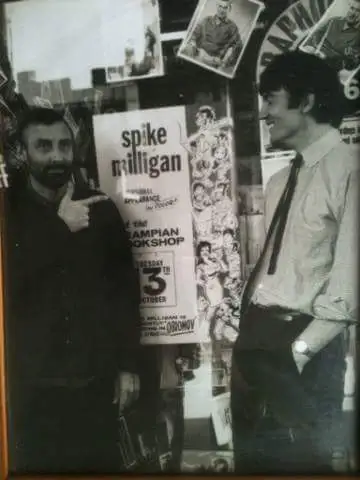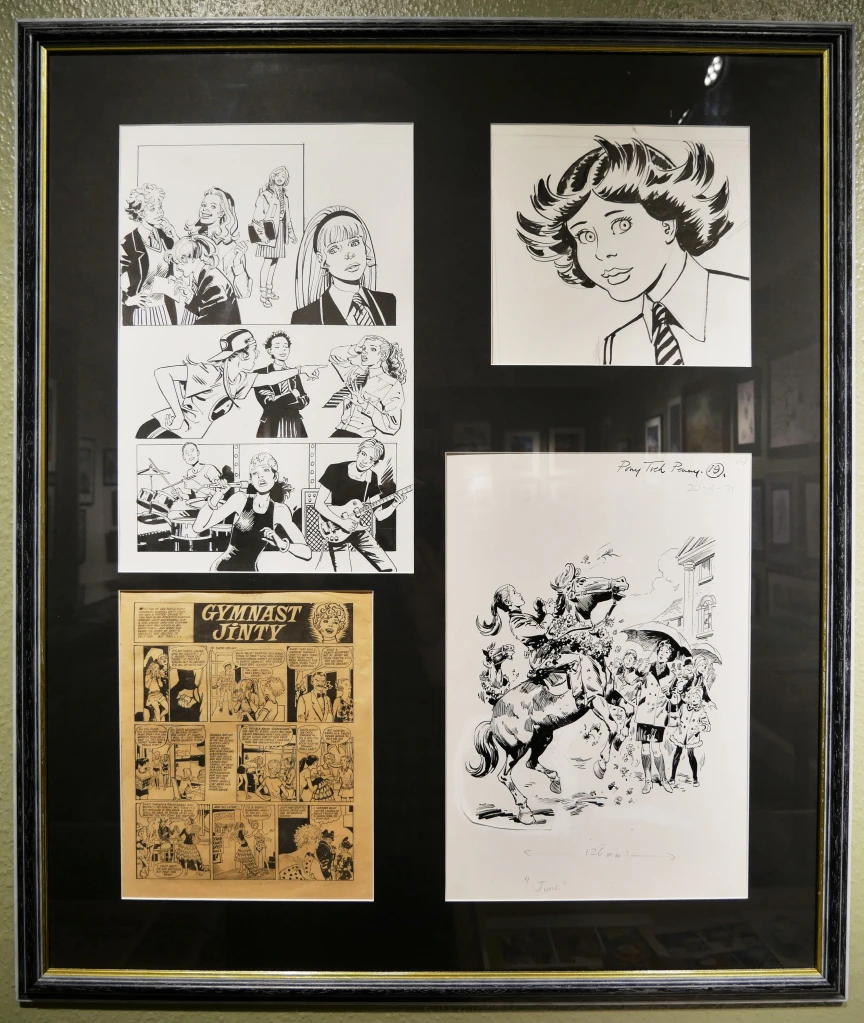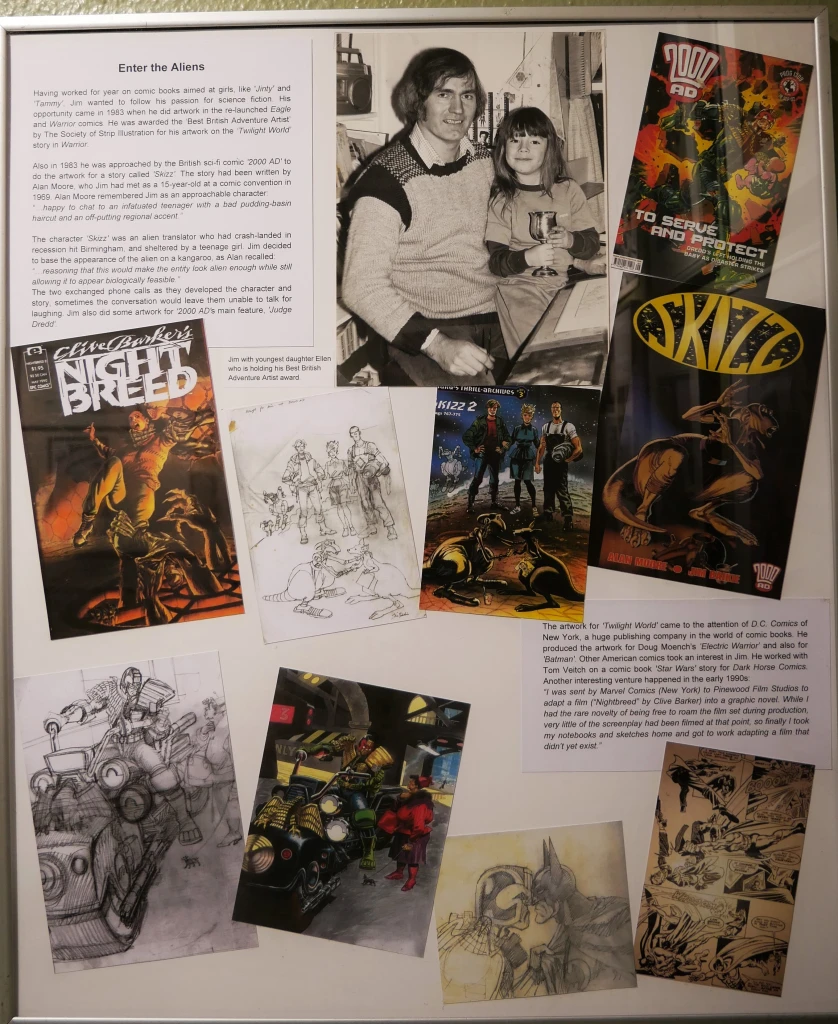The Life and Times of Orkney artist Jim Baikie

Author: Tom Muir, Engagement and Exhibitions Officer
I have worked at the Orkney Museum since 1988 and in that time I have done all sorts of jobs, from Assistant Custodian to Museum Assistant to Exhibitions Officer. I have, though, created temporary exhibitions from the beginning. I have researched, written and set up too many exhibitions to number, both at the Orkney and Stromness Museums, plus other displays as outreach, from Sanday to Bergen. In all my time doing this job I have never enjoyed putting together an exhibition as much as I have loved this one. The story of Jim’s life is incredible, as he played bass in bands in London during the 1960s while forging a career as a comic book artist.
He is regarded as one of the greats, working for 2000AD, Marvel and DC Comics, to name but a few. This exhibition brought in so many people that we have decided to have a much expanded show on Jim’s life and art for our summer exhibition in 2023, which will run from May-September. So, in tribute to Jim Baikie, here is a taste of his remarkable life and talent as an artist.

James George Baikie was born at Boathouse, Crockness, North Walls, Hoy on 28th February 1940. His parents were Vic and Nettie Baikie. Vic is usually recorded as a blacksmith, but he was mostly employed as a highly skilled welder working at the Lyness Naval Base. He had one sister, Janice, who was born on the 3rd May 1941.
The war did bring some unexpected bonuses to the young Jim, as comic books were washed ashore from the battleships that were anchored nearby. These might have been from American naval ships, but to him they were “freebies in the ebb-tide.” Many of these comics had pages missing, so he would invent his own beginnings and ends of stories. A lifelong passion was born.
As his school years drew to a close, and with no luck in becoming a cartoonist, Jim had to find a career. He decided to join the RAF, maybe influenced by his father who served in the RAF during the war. On the 14th February 1956 he entered RAF College Cosford as a Boy Entrant. He thought that this would be a chance of receiving further education and a career, as well as the opportunity to travel. His family all agree that Jim was not cut out to be in the military.
Later in 1958 Jim was promoted to Corporal and sent to RAF Craigiebarns, Dundee. Here he taught Administration Procedures to the Dundee branch of the Royal Auxiliary Air Force. He took the opportunity to enrol at the Duncan of Jordanstone Art College, where he attended the daytime sessions with the Diploma Class.
He juggled this with his duties at the RAF base. His attendance at the college was helped by the D.C. Thomson artist, James Reville, who was one of the lecturers. Reville was better known under the name J. Campbell Kerr, the cover artist of ‘The People’s Friend’.

Jim applied to purchase his discharge from the RAF, but this proved to be a slow process. There was one thing that prevented him from leaving. He had fallen in love with Wendy Lawson, the daughter of a warrant officer at Leuchers.
When Wendy’s father was transferred to Germany, along with his family, Jim applied for an overseas posting as well. Instead of following Wendy to Germany, Jim found himself posted to Akrotiri, Cyprus in September 1960. Jim and Wendy were married on 3rd April 1961.
The couple would have five daughters, Jacqueline, Jane, Vanessa, Caitrian and Ellen. Jim bought himself out of the RAF 26th February 1963 and the couple moved to London.
Jim had taught himself to play guitar, and while in Cyprus he joined the band The Whirlwinds. On his arrival in London he joined the band Jaymes Fenda and the Vulcans, who played as a support group to The Kinks and The Pretty Things.
Their rhythm guitarist was a very young John Ford, who would find fame as the bass player in The Strawbs. Jim joined in blues and R&B jam sessions upstairs in pubs, with Ritchie Blackmore, who would recommend Jim as a bass player for Screaming Lord Sutch’s band. Jim declined joining Sutch on a tour of Germany as it meant leaving home immediately.
Jim left Jaymes Fenda and the Vulcans and joined The Cross Ties Blues Band, which was fronted by Dave Peverett, who would later be in the bands Savoy Brown and Foghat. During this time he was rubbing shoulders with The Rolling Stones, Eric Clapton and Jack Bruce, who he jammed with at a party. He continued to play after returning to Orkney, but just for the love of it.


Life after the RAF
On leaving the RAF and moving to London Jim got a job working for Letraset Ltd, making rub-off transfer lettering. In March 1964, after a year working for Letraset, Jim joined Grampian Press as a general artist. Here he found himself working on publicity material for Spike Milligan, the comic genius whose Goon Shows Jim had loved.

They shared a zany sense of humour (which Jim had developed by listening to Spike on The Goon Show) and laughed a lot together Yet Spike was a troubled soul, suffering from bipolar disorder. It was touching to hear that when Spike became overwhelmed by people wanting to meet him that he turned to Jim to help him get away from the crowd. A wonderful sense of trust.

In April 1965 Jim took the post of illustrator with National Savings in Kingsway, London. He was also working freelance as an artist with Fleetway Publishings, working on the teen girl romance comic ‘Valentine’. Here Jim got a lucky break, as he later recalled:
“The crunch came when an artist’s agent got into the elevator as I was leaving Fleetway. By the time we came out into the street I had accepted my first full-colour assignment, to illustrate a two-page weekly feature about the pop group, ‘The Monkees’. The desk job had to go.”

Jim was now a full-time artist, illustrating strip cartoons of TV shows like ‘The Lone Ranger’, ‘Thunderbirds’, ‘Joe 90’, ‘Captain Scarlet’, ‘Dr Who’, ‘Star Trek’ and ‘Charlie’s Angels’ and for comics like ‘Lady Penelope’, ‘TV 21’ and ‘Look In’. He would later recall events in October 1966:
“I was freelance. With the help of Ken Livingstone’s GLC, we’d bought a house in South Norwood, London. There was an outside toilet between the garden shed and the house, and a local builder transformed it into the smallest studio I ever had. I hardly got out of there for five years, except to deliver artwork, and even then I’d be on the train tweaking Mr. Spock’s eyebrows, or putting highlights on Charlies Angels’ lip-gloss.”


By 1970 the house in London was becoming too small for the growing family. Jim’s thoughts turned to his island home, as he recalled:
“We needed a bigger house. As far back as I can remember, I had hankered to go home to Orkney. Wendy, too, fancied an island life, but I told her the Seychelles were out of the question. My father had made a few enquiries. The old Signal Station, a wartime operation room built into the hill overlooking Lyness was available, bomb-proof reinforced concrete, a snap at £38. Wendy and I went to look at it, and there was a dead sheep on the roof. We decided not to measure it for carpets.”
The Old Mill at Rysa belonged to Jim’s parents, who lived nearby. This was considered, as Jim explained in an interview with ‘Orkney Today’:
“I’d come up to do some serious thinking about the mill. But had been told that the conversion was going to take a long time and we needed a place now. So I went to Stromness solicitors, J.E.P. Robertson, and asked if they had any kind of reasonably-sized house. They said that there was an old place that was well past its best, The Leigh in Stenness, and when I was shown through it, I said, ‘I’ve got to have this.’ That was in 1972. We moved into the house and we’re still doing it up – 30 years later.”

Having left his agent and gone solo Jim had to prove that he could carry on working successfully from Orkney: “Many clients became cautious when they saw the new address, but when they realised the mail service was quicker from Orkney than it often was from South London, everything settled back to the same old routine.”
Jim recalled a visit to the local shop: “I came across someone in Stenness post office, and he said, ‘the last time we met you were over in Hoy, aged seven, drawing cowboys’ and he said ‘what are you doing now,’ and I said ‘drawing cowboys.’ ”
Enter the Aliens

Having worked for years on comic books aimed at girls, like ‘Jinty’ and ‘Tammy’, Jim wanted to follow his passion for science fiction. His opportunity came in 1983 when he did artwork in the re-launched Eagle and Warrior comics. He was awarded the ‘Best British Adventure Artist’ by The Society of Strip Illustration for his artwork on the ‘Twilight World’ story in Warrior.
Also in 1983 he was approached by the British sci-fi comic ‘2000 AD’ to do the artwork for a story called ‘Skizz’. The story had been written by Alan Moore, who Jim had met as a 15-year-old at a comic convention in 1969. Alan Moore remembered Jim as an approachable character:
“…happy to chat to an infatuated teenager with a bad pudding-basin haircut and an off-putting regional accent.”
The character ‘Skizz’ was an alien translator who had crash-landed in recession hit Birmingham, and sheltered by a teenage girl. Jim decided to base the appearance of the alien on a kangaroo, as Alan recalled:
“…reasoning that this would make the entity look alien enough while still allowing it to appear biologically feasible.”
The two exchanged phone calls as they developed the character and story, sometimes the conversation would leave them unable to talk for laughing. Jim also did some artwork for ‘2000 AD’s main feature, ‘Judge Dredd’.
The artwork for ‘Twilight World’ came to the attention of D.C. Comics of New York, a huge publishing company in the world of comic books. He produced the artwork for Doug Moench’s ‘Electric Warrior’ and also for ‘Batman’. Other American comics took an interest in Jim. He worked with Tom Veitch on a comic book ‘Star Wars’ story for Dark Horse Comics. Another interesting venture happened in the early 1990s:
“I was sent by Marvel Comics (New York) to Pinewood Film Studios to adapt a film (“Nightbreed” by Clive Barker) into a graphic novel. While I had the rare novelty of being free to roam the film set during production, very little of the screenplay had been filmed at that point, so finally I took my notebooks and sketches home and got to work adapting a film that didn’t yet exist.”
Like most Orcadians of his age, Jim never made a fuss about what he did or what he knew. He was always remembered as a humble man who always made time for others. No young artist was turned away when they contacted him at home or abruptly dismissed when he attended comic book conventions.
He encouraged young artists instead of treating them as a future threat. In fact, it was the future that Jim always though about. If you don’t nurture young artists and writers, what future does comic books have to look forward to?

Jim had an enquiring mind and he read extensively on a variety of subjects. Although not a religious man, Jim loved to study religion and philosophy. Wendy recalled that he was “…certainly not afraid of death.” The arts too was something to be studied as well as loved. He compiled a large archive of pictures from magazines that he could refer to in his artwork, especially photographs of people in various poses. These he kept in what he called “…the morgue.”
During the 1970’s and 1980’s, Orkney was under threat from commercial uranium mining. Deposits of uranium lie along the West Mainland coastline, from Yesnaby to Stromness. The prospect of open cast mining led to protests in Orkney.
Jim’s family remember his a man who was a deep thinker. He loved science and immersed himself in books and theories. He believed in the possibility of parallel worlds and expanding universes. Not only did he think deeply about such complex scientific theories, but he had the ability to explain them to others in a simple manner.
He once explained Einstein’s Spacetime Continuum to a young artist my pinching a tablecloth in order to bring together two gravy stains. Jim knew that if you wanted to draw and write science fiction you had to understand science, and all its extraordinary concepts.
In 1984 Jim was awarded a Churchill Fellowship, which was normally awarded to people carrying out scientific, medical and environmental research. Jim, though, had other plans:
“1984, Awarded Winston Churchill Travelling Fellowship to visit America for two months studying the business of comic book production, studio systems and print works. I met many of my heros, including the venerable Burne Hogarth ‘The Michaelangelo of the comic strip.’ Hogarth introduced me to Hollywood producer Jack Cummings (‘Seven Brides for Seven Brothers’) who later drove me all around Hollywood.”
Jim drew a cartoon of a spaceman from Earth landing on a planet and being met by an alien who asked him if he had done his Churchill Fellowship paperwork yet. When a group of Churchill Fellows visited Orkney recently they said that Jim’s cartoon was still hanging on their office wall.



Just when it seemed that everything was going Jim’s way, in 1991 he had a devastating piece of news:
“A stiffness in my left arm was diagnosed as a form of Parkinson’s Disease, and I decided it was time to slow down and consider my future. I took up script-writing and cut back on the artwork. Richard Burton, then editor of 2000 AD, said there was interest in a sequel to Skizz, but writer Alan Moore didn’t want to do it. So I offered a plot which was accepted, and I spent a marvellous time away from the drawing board, made even easier by Wendy’s decision to expand what had been her hobby (silkscreen printing her own textile designs) into a full fledged business. But soon I wasn’t just writing Skizz, I was drawing it too, and as colour printing suddenly took off about then, I painted it. After it was published (and repackaged as a graphic novel by Mandarin Books), 2000 AD commissioned another sequel which again I wrote, drew and painted.”
Jim carried on his work as the Parkinson’s Disease slowly reduced his mobility. In 1998 he was reunited with Alan Moore on a spoof super-hero strip, ‘The First American’ in ‘Tomorrow Stories’, published by America’s Best Comics. In 2000 he was awarded two Eisner Awards for services to the comic industry. But tragedy struck when, on 15th April 2008, Jim and Wendy’s daughter Jane died suddenly after a short illness. It was a devastating blow for the whole family.
he Parkinson Disease continued to take its toll on Jim. Eventually, he needed specialist care and was admitted to the Smiddybrae care home in Dounby. Here he was popular with the staff and other residents. He was remembered for entertaining them by playing his guitar and singing. Afterwards he would thank people for listening to him. Visits from Wendy and the family were happy occasions, with glasses of red wine and laughter. It was observed by one member of staff that:
“Jim had many good qualities but what he lacked Wendy seems to have by the bucket load. Like ying and yang or mealy puddings and clapshot, they truly complemented one another.”

Jim Baikie died on the 29th December 2017, aged 77 years. This February 28th would have been his 80th birthday. Jim and Wendy had five daughters, 12 grandchildren and 2 great-grandchildren. At a memorial service tributes were given by the family and read from staff at Smiddybrae, the writer Alan Moore and the artist Stewart Moore, who studied with Jim in 1988 as part of his degree course. He said:
“I’ll always remember his succinct demonstration of warping spacetime by pinching together two gravy stains on a table cloth.”
Jim was a giant in his chosen career, yet he encouraged up-and-coming young artists whenever possible and loved to teach. He once said:
“There is an argument that we’re in such a small industry, where there is not much work going about, that if you encourage a youngster, you are encouraging competition for yourself. But I can’t get into that kind of thinking.”
Jim was too much of a gentleman to harbour such thoughts.





















